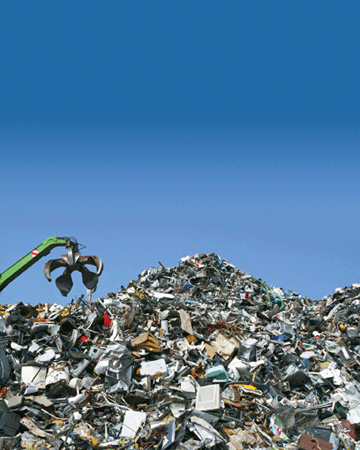
|
Published:
Securing South Australia’s coastal bounty
An incredible diversity of marine species was recently recorded in the Chain of Bays, about 700 kilometres west of Adelaide, during an inaugural near-shore marine survey of the region by volunteer divers. The find has added weight to the efforts of the state government and other stakeholders to work to safeguard the region. Wendy Pyper reports.
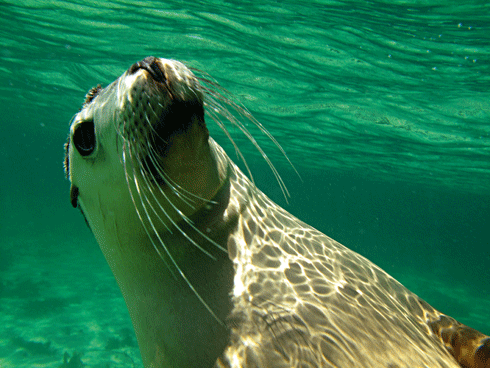
|
|
An Australian sea-lion at play in Baird Bay – seeing these animals up close in the wild is a priceless experience for many visitors. Credit:
Grant Hobson
|
Beneath the crystal blue waters off South Australia’s western Eyre Peninsula exists a largely unknown ‘rainforest’ of seaweeds and seagrasses that protect and support an incredible richness of marine life, including Western blue gropers – some up to 1.5 metres long – abalone, nudibranchs, southern rock lobsters and Australian sea-lions.
‘In many places elsewhere you see a lot of rock and barren areas, but the Chain of Bays has a lush area of seaweed, which naturally creates a more complex environment, much like a rainforest does on land,’ says survey diver, Mr Bill Barker. Mr Barker was part of a five-strong team of volunteer divers from Reef Life Survey,1 led by marine scientist Dr Marlene Davey, that conducted a marine audit during February on behalf of the community conservation group Friends of Sceale Bay. The Friends, with assistance from marine ecologist Janine Baker, had successfully applied for a Commonwealth Caring for our Country Community Coastcare grant to fund the survey.
The divers surveyed 13 shallow reef sites in Corvisart, Sceale, Searcy, Baird and Anxious bays – five of the seven interconnected bays that make up the Chain of Bays (Venus and Streaky bays complete the chain). Along 36 survey lines (‘transects’), each 50 metres long, they counted, classified and photographed fish, invertebrates, marine mammals and algae.
‘We saw an enormous diversity of marine life during the survey, but it was fantastic to see so many juvenile and large Western blue gropers,’ Dr Davey says.
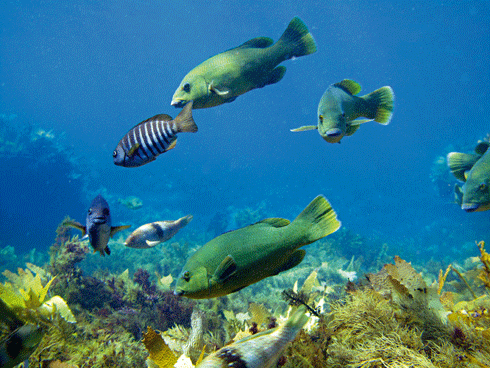
|
|
A school of juvenile blue groper at Baird Bay over a seabed of diverse algae. Credit:
Grant Hobson
|
‘These fish are quite often the first to be killed by recreational and professional fishers, so they can be seen as an indicator species.’
Friends of Sceale Bay convener, Grant Hobson, says the survey aimed to obtain data on local sub-tidal biodiversity that will assist ongoing management of the marine parks recently established in the region, provide baseline information for monitoring future change, and contribute to a national dataset used to manage Australia’s marine resources.
‘The survey is part of a 10-year campaign by the Friends of Sceale Bay to have the area’s wealth of coastal and marine biodiversity recorded and managed, so that we can protect it for future generations,’ he says.
The Chain of Bays (currently excluding Corvisart and Streaky bays and Olive Island) has been incorporated into the West Coast Bays Marine Park (Marine Park 3), covering a 789-square-kilometre region. The park is one of 19 new marine parks established by the state government in January 2009 that encompass some 46 per cent of South Australia’s coastal waters and contribute to a National Representative System of Marine Protected Areas.2 Management plans and usage zones (general managed use, habitat protection, sanctuary and restricted access zones) within the parks’ boundaries will shortly be developed in consultation with the community, industry and local advisory groups.
‘This is a unique opportunity to establish a series of large sanctuary zones within Marine Park 3,’ Mr Hobson says.
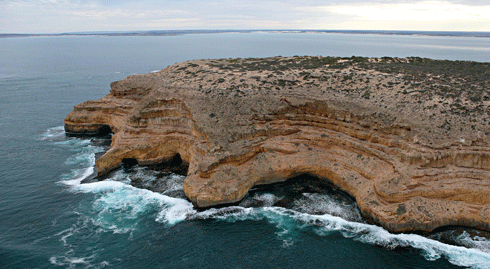
|
|
The rugged cliffs of Cape Blanche – home to sea eagles and southern osprey. Credit:
David Joy
|
‘Recreational fishing is exploding in the region and we’d like to see larger sanctuary zones, from which outward migration of fish would occur, to support this.’
Friends of Sceale Bay also advocate greater habitat protection for the endangered Australian sea-lion. The Chain of Bays is home to 10–15 per cent of the population and while conservation parks have been established around breeding areas, inappropriate fishing, boating and other activities still occur close to and within them.
‘There is limited ranger presence in these existing sanctuaries. For the new marine parks to be effective, the government will have to ensure an ongoing ranger presence and appropriately equipped marine presence,’ Mr Hobson says.
His concerns spring from a history of conservation-related issues in the region (see ECOS 140, pp. 18–21). These include the recent shooting of two endangered white-bellied sea eagles3 and a juvenile osprey, purportedly over coastal development disagreements in the Streaky Bay area; jet ski towing near osprey nest sites; and an invasive rescue and salvage operation, launched when a fishing boat washed up on Nicolas Baudin Island – part of the Australian sea-lion sanctuary – after recreational lobster fishermen encountered trouble while fishing adjacent to the island’s exclusion zone.
‘While our survey reinforced the relatively undisturbed nature of the Chain of Bays, there are a growing number of pressures such as aquaculture expansion, overfishing, unregulated access and people going about things in a way they would not if the area was well policed and regulated,’ Mr Hobson says.

|
|
Reef Life Survey diver Bill Barker was excited by the incredible diversity of the near-shore ecosystems. Credit:
Grant Hobson
|
‘Given the rich biodiversity and unspoilt nature of the marine environment I’d argue that it should be considered an area for scientific benchmarking, requiring larger sanctuaries and resources to manage these.’
However, concern over the rationale for marine parks, their effectiveness, their size and the zoning process, has been voiced by commercial and recreational fishers, the seafood industry, the Liberal Opposition and some fisheries scientists. South Australia’s Environment Minister, Jay Weatherill, has responded to these concerns through public meetings, information packages4 and by encouraging participation in local marine park advisory working groups.
While fishermen will be compensated for any impact on their business, ecotourism operator Alan Payne won’t be, if the new zoning prevents him running his sea-lion and dolphin tours. Despite this risk, he has confidence in the public consultation process and believes the marine parks are in everyone’s best interest. To this end, he even ferried the marine survey team around in his boat.
‘I don’t see a problem with the marine parks. The restricted zones will be arguable and the community must make the government account for why we should stop using them. But in turn we need to understand the reasons and accept them. We need to think about the future,’ he says.
‘Every year more people come to these areas to take their share of fish. There’s also increasing pressure on the environment and visual amenity from coastal subdivisions and developments. If we keep going the way we are we’ll end up like the Gold Coast and we’ll lose the very things that make people want to live here and to visit.’
It’s a scenario and set of challenges common to a number of remote coastal areas around Australia. In the Chain of Bays, the marine park process comes at an opportune time to link with a coastal conservation process that should avert any comparisons with the Gold Coast. In November 2008, Minister Weatherill announced the establishment of a CoastLinks Conservation Area between Venus and Streaky bays that will link existing reserves, unallotted crown land, heritage agreements and new land purchases to create connected habitat across lands managed for conservation objectives.5
‘This is a unique opportunity to have a park with terrestrial and marine management components, with both habitats so well represented by iconic species which, in some cases, have potential pre-European concentrations,’ Mr Hobson says.
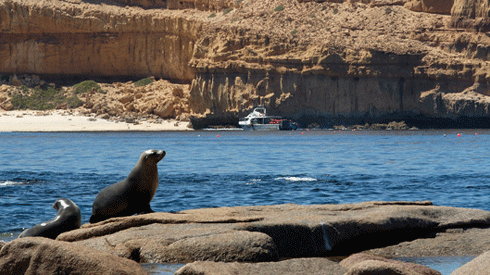
|
|
Cray fishermen operating near the protected Australian sea-lion colony on Nicholas Baudin Island. Credit:
Grant Hobson
|
To bring the CoastLinks vision to fruition, local councils have been involved in developing the Eyre Peninsula Coastal Development Strategy. Councils implement this strategy, and establish new Conservation Zones, through Development Plan Amendments (DPA) – which are approved by the Minister for Urban Development and Planning.
However, the Friends of Sceale Bay and others are concerned that the Streaky Bay Council is preventing full implementation of the CoastLinks objectives. The council has been criticised for its ‘adversarial’ approach to coastal development, which includes building houses adjacent to sensitive osprey nest sites, despite objections from the state government and others, and inappropriate clearing of native vegetation.6,7
A spokesperson from the Department of Urban Development and Planning says the Streaky Bay Council chose to undertake a DPA in December 2007 and is currently working in consultation with the Department of Planning and Local Government.
‘The policy in the existing Streaky Bay Development Plan already contains a Coastal Zone where some development is envisaged in balance with protection of the coast,’ the spokesperson says.
Only last year, however, the council was refused a request to rezone land at Cape Bauer – important raptor breeding habitat – for tourist accommodation and housing.
‘I would strongly advise Streaky Bay Council to focus on amending its Development Plan to reflect the aims of the joint coastal development strategy,’ Urban Development and Planning Minister, Paul Holloway, said in a media release.8
‘The proposed rezoning at Cape Bauer is seriously at odds with the Eyre Peninsula Coastal Development Strategy.’
Some gains have been made towards the CoastLinks Conservation Zone, however. Director of National Parks and Wildlife in South Australia, Greg Leaman, says negotiations for the purchase of private land in the Chain of Bays is being finalised and will add 1200 hectares of land to existing parks. Work has also commenced on adding unallotted crown land to the parks system. On the question of Streaky Bay Council’s commitment to the conservation vision, Leaman says discussions have commenced with the council on identifying priority land management actions and potential partnerships.
‘Implementation of the actions outlined in the CoastLinks report9 will be progressed over time, as partnerships are developed and resources obtained,’ he says.
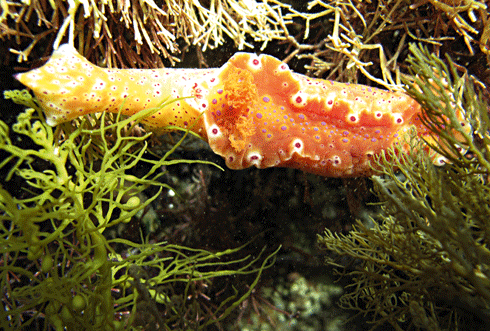
|
|
A nudibranch feeds on seaweed at Smooth Pools. Credit:
Grant Hobson
|
The future of the Chain of Bays depends on the success of the state government engaging all sectors of the community and convincing them of the value of the marine parks and CoastLinks processes and the natural resources – and lifestyles – they aim to protect. Alan Payne’s ecotourists can see it, but can the locals be convinced?
‘Foreign tourists can’t believe how good this place is – some Americans once compared it to the Galapagos Islands,’ Mr Payne says.
‘I hope we are smart enough to realise it too.’
1 A national program of the People and Parks Foundation,
http://www.reeflifesurvey.com/?page_id=65
2 http://www.environment.sa.gov.au/marineparks/index.html
3 Peddie C (2008) Outrage as endangered sea eagle shot dead. Adelaide Now, 6 February.
4 Marine parks – questions and answers, media release, 17 April 2009.
http://www.environment.sa.gov.au/data/press/090417MParksQAs.pdf
5 ‘More protection for West Coast wildlife’, 20 November 2008. http://www.ministers.sa.gov.au/news.php?id=3980
6 ‘The right to a view’. Earthbeat, radio program, 11 October 2003. http://www.abc.net.au/rn/science/earth/stories/s963128.htm
7 ‘Coastal development’. Sixty first report of the Environment, Resources and Development Committee. Parliament of South Australia, 20 November 2007, pp. 58–61.
8 Cape Bauer rezoning proposal refused, media release, 10 September 2008. http://www.ministers.sa.gov.au/news.php?id=3658&print=1
9 ‘Report on opportunities for the protection of coastal land between Streaky Bay to Venus Bay through establishment of a CoastLinks Conservation Area’. Department for Environment and Heritage, Adelaide, 2008. http://www.environment.sa.gov.au/biodiversity/pdfs/coastlinks_report.pdf


